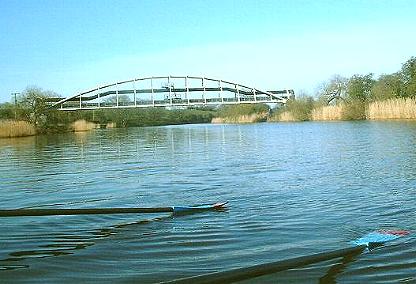
A useful landmark and known simply as “The Pipe Bridge” but behind the apparently mundane functionality of this bowstring bridge lies an intriguing story of engineering skills. The bridge was constructed by Dowsett in 1959 to carry two 33 inch (840 mm) water supply pipes to serve the south Teesside area. It comprises pre fabricated concrete parts which were brought from Lincolnshire. In order not to obstruct the river the engineers assembled the “kit of parts” on the Durham bank having pre prepared concrete abutments on each side of the crossing. The whole unit spanning 210 feet (61 metres) and weighing 200 tons was then rolled across the river on a Bailey Bridge (a type of temporary rapid deployment bridge developed in the Second World War) before being shifted sideways on to it’s abutments. The “launch” operation was recorded on cine film (the home video of the day)and an Evening Gazette journalist was present – a report appearing in that paper on 3rd February 1959.
In 1979 a refurbishment scheme was carried out during which a third water pipe was added. At that time another pipe bridge, built in 1865 just upstream of the boathouse, also carried water across the river. The extra pipe on the 1959 bridge enabled the old bridge to be declared surplus to requirements and it was demolished by the Water Authority shortly afterwards. The distance from the here to the A66 Surtees Bridge is 4250 metres (2.64 miles) and this stretch of river has been used by crews and scullers as a standard “time trial track” on which to monitor their endurance training.
Now that there is a new bridge which tends to obstruct visibility downstream of the Pipe Bridge it is strongly recommended that any “time trials” to the A66 are started from the new road bridge rather than from the Pipe Bridge. On the face of it navigation of these bridges and their downstream bend seems to be straightforward. But, it is very easy to drift off course so please keep an extra sharp look out for any boats which may be coming in the opposite direction. Some of them, canoes in particular, are known to cut this and other bends on the wrong side of the river where you may not be expecting to see them. So – just in case and to allow them an escape route – do not get too close to the “inside” river bank. In the event of a collision being on the correct side of the river is all very well in terms of the law but it is better in the first place to spot and avoid the hazard rather hitting it….
Above the Pipe Bridge is a fairly straight reach about 500 metres long. The river then goes through a series of tight bends before reaching Preston Park. Navigation through these bends is fairly straightforward for small boats but much more tricky for an eight. For serious training sessions eights are best not taken above the top of Pipe Bridge reach.